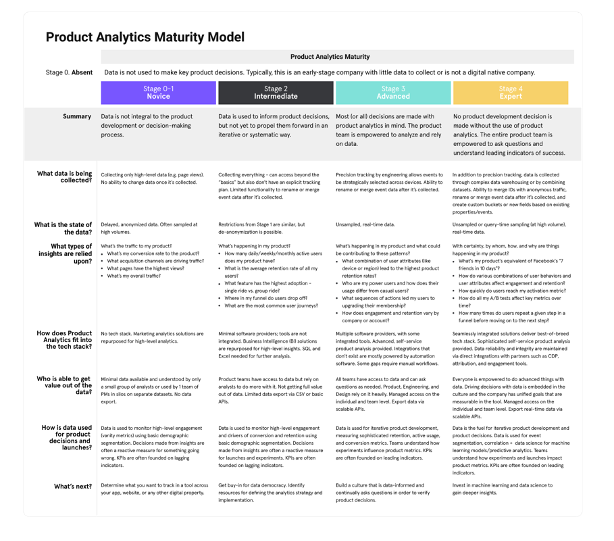Published by
First things first, let’s level set. If you are a product manager that is feeling increased pressure from your business to use your first-party data to drive digital product growth, you are not alone. It is common knowledge among product professionals that product analytics is critical to driving growth, but the bar to meet the increased expectations from both your business and customers is only getting higher as we move into 2021. We believe this is being magnified largely due to three factors:
- The prolonged pandemic has caused most businesses to see digital products as the only means to engage with a large portion of their customer base.
- Apple’s shift away from the IDFA will remove end-to-end customer journey visibility for many advertising, marketing, and product teams, thus resulting in the need for more dependable insights.
- Third-party cookies continue to crumble after Google said it will begin phasing them out from Chrome browsers.
In response to this pressure, all eyes are turning to customer and employee first-party data–the data your product team or wider business has collected directly from your customers, site visitors, and social media followers as they interact with your business.
Because the party collecting the data does so first-hand, without additional layers like Apple’s advertising identifier, first-party data is typically considered more dependable. This data can hold important answers teams need to continue creating and evolving the quality digital products and services their customers expect. Whether you are taking your first step into digital as a business, like T.J. Maxx for example, or if you are a mature, product-led business that makes data-based decisions like Airbnb, it helps to have a clear framework to help navigate this journey and increase your digital maturity by better leveraging first-party data along the way.

Product Analytics Maturity
As Mixpanel outlines in their Advance Your Product Analytics Strategy guide, product analytics maturity refers to where a company stands in the product analytics lifecycle. At its core, product analytics maturity is made up of four pillars: data collection, depth of analysis, collaboration, and product metrics. Your product analytics maturity determines your capability within each of these areas, and ultimately how the business is relying on data to make product decisions.
If you are unsure of where your product currently stands, you can take this online quiz that comes along with the Advance Your Product Analytics Strategy guide – here.
Asking the Right Questions
The questions that your team(s) ask throughout your product development lifecycle (strategy, design, build and grow), will influence future decisions and the future of your product. Ultimately, the depth of insights that you can ask of your tool—or that you’re asking of your own product—is the primary driver of maturity.
Throughout my interactions with various product teams, understanding how to figure out the right questions to ask and how these questions evolve over time is one of the biggest challenges I see product managers come up against.
Here are a few best practices I keep at my side when going into each new business endeavor:
- Be extremely specific with your questions. The more specific it is, the more valuable it will be. Instead of asking “How can we raise revenue?”, you should instead ask “Which new feature in the last six months drove the highest ROI and how can we replicate its success?” (source)
- Try it out yourself. Put yourself into the shoes of your customers and your competitors’ customers by regularly using your product and your competitors’ product. These regular “secret shopper experiences” are a gold mine for crafting impactful questions that drive immediate growth. Be sure to write down questions and pain points that come to mind in real-time as you go through the various product experiences.
- Industry and product type matters. Get a list of common questions asked by industry through your product analytics provider, digital agency, or by searching online. As stated above, the best questions are specific, and this specificity applies to industries as well. A transactional-based product in the airline industry will require very different questions to be asked than an attention-based app in the media and entertainment industry, for example.
- Ask your colleagues for help. Look to adjacent organizations in your business and ask them what their key performance indicators are and what questions keep them up at night. Not only is this a good way to expand the questions you are asking to encompass the goals of your wider business, but it is also an easy way to start a dialogue in a siloed work environment while addressing a common goal.
- Keep first-party data in mind. Consider whether or not data from 3rd party providers (ad networks for example) will be needed to answer certain questions. If you can get to an insight without relying on a 3rd party provider, do it. Further, if there are existing questions you can answer with first-party data, do it. This will save you from the headache when Apple follows through on this planned change in January.
From our perspective, there isn’t a magic formula for generating these questions. It is mainly a skill that is built based on practice and experience similar to any other skill or sport you strive to be great at. I find keeping a clear list of current and past questions along with performance data to validate or invalidate impact is an easy way to reach the most relevant questions for your business.
In summary, as we move into 2021, your ability to grow and respond to changes your product encounters in the market will become increasingly more dependent on your company’s current level of product analytics maturity. Using a product analytics maturity framework to baseline your current level and to guide your product to more advanced levels is a critical component often observed in high-growth product teams. Further, the questions that you and your product team ask will drive the majority of your focus and should be created with a set of best practices in mind. If you want to get started understanding and then improving your product analytics maturity today, here are a few recommended next steps:
- Identify what your current product analytics maturity level is.
- Consider how third-party vs. first-party data factors into that maturity level.
- Plot your course to advancing your maturity considering any necessary shifts you should make in terms of the data you rely on to make decisions and the tools in your stack.
About the Author
Tim is the lead of Bottle Rocket’s growth practice and an active thought leader on digital product growth in the marketplace.
Sources




